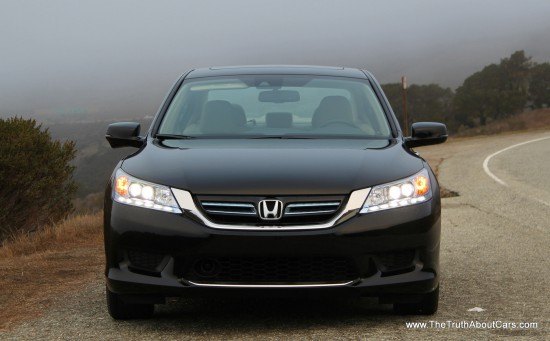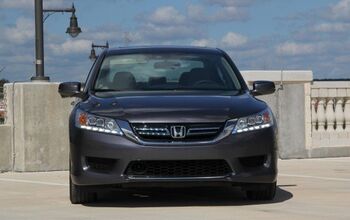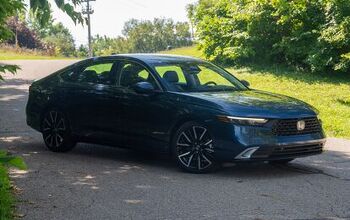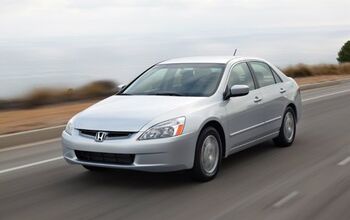Review: 2014 Honda Accord Hybrid (With Video)

Now and then you run into a car that just “fits”. It’s like finding a perfect shoe, or a comfy smoking jacket. Until now I have been keeping my secret love on the down-low for several reasons. First off, I’ve always thought having a “favorite car” tends to color one’s judgment when comparing cars, so I try to avoid such statements. Secondly, my dalliance with my automotive flame was fleeting. As most of us know, one-night-stands rarely hold up to the scrutiny of a long-term relationship. And lastly, coming out as a hybrid-lover has been difficult. When folks ask me “what was the best car you drove in 2013?” and my answer is “the 2014 Accord Hybrid,” they stare at me like I have three eyeballs.
Exterior
The Accord is the mid-size sedan least likely to offend. While some call the tall greenhouse and upright proportions boring, I found them to be elegant and restrained. Indeed the Accord’s side profile reminds me a great deal of former Lexus products, a similarity that was shared by passengers during the week. Several passers by even confused the Accord with a Lexus ES. This is good news for Honda but bad news for Lexus.
Up front the Accord Hybrid wears blue-tinted versions of the regular Accord’s grille and headlamps instead of the Plug-In Accord’s enormous maw. Our Limited trim model was equipped with LED headlamps but lesser trims have to get by with halogen bulbs. Out back the restrained styling continues with hidden exhaust tips, clean lines and plenty of LEDs in the tail lamps. While there are plenty of mid-size sedans out there, the hybrid market is limited to the Accord, Camry, Fusion, Optima and Sonata. In that lineup, I find the Fusion the best looking with the Accord in a solid second place and the refreshed Optima taking third.
Interior
Like the gas-only Accord, the hybrid sports a double-bump style dashboard. The first “bump” houses the same tweaked instrument cluster as the Accord plug-in with a large analog speedometer, no tachometer, LED gauges for battery/fuel and a power meter. Inside the speedo is a circular full-color LCD used for the trip computer, secondary nav instructions (if so equipped) and other vehicle information. Housed in the second “bump” is a standard 8-inch infotainment display.
Front seat comfort has long been a Honda strong suit and the Accord is no different with thickly padded and ergonomically designed thrones. The seats are lightly (and widely) bolstered so larger drivers and passengers shouldn’t have a problem finding a comfortable seating position. Because the EX trim of the gas Accord serves as the “feature donor car” for the Hybrid, all models get adjustable lumbar support, 10-way power driver’s seat, dual-zone climate control, tilt/telescoping steering wheel, standard Bluetooth, a backup camera, keyless entry/go and active noise cancellation.
Thanks to the tall green house and complete lack of “four-door-coupé” styling cues, the Accord’s rear seats are the best in the segment. On paper there’s nothing extraordinary about the rear cabin dimension. The truth is in the sitting. The Accord’s rear seats are more comfortable than a Camry and roomier than an Optima or Sonata. The seat back angle is also the most upright of the bunch allowing easier entry and exit when compared to the reclined Fusion. That reclined rear seat is how the Fusion manages to match the Accord when it comes to inches of head room, but the Accord’s rear compartment is far more accommodating.
As with most hybrids, there’s a trunk penalty to be paid. Thanks to energy dense Lithium-ion cells, the Accord only drops 3 cubic feet to 12.7 cubic feet, and I had no problem jamming six 24-inch roller bags in the trunk. The Li-ion cells mean the gas-only Accord’s smallish trunk translates in to a roomy storage area compared to the other hybrids. Sadly everyone else has managed to preserve some sort of cargo pass-through to the trunk while Honda decided to kill it. Honda wouldn’t say what the reason was, but judging by the battery position there was still room for a cargo slot capable of handling a surf board. Call that an opportunity lost.
Infotainment
Base models use physical buttons to control the standard 8-inch LCD in the dash, while up-level Accords get the two-screen layout you see above. Bluetooth, SMS voice messaging, Pandora smartphone integration and USB/iDevice control are all standard on base models as is a 6-speaker, 160-watt sound system. The 8-inch LCD handles all infotainment interactions in this base system from playlist browsing to phone dialing. Honda integrates their active noise cancellation technology into the head unit, so keep that in mind if you plan to swap into an after-market unit.
I suspect that most shoppers will opt for the mid-level “EX-L” which adds a subwoofer, 360 watt amp, and a 6-inch touchscreen for audio system controls. For reasons I don’t understand, the touchscreen is surrounded by “sparkly” plastic that looks like someone tossed in some glitter in the last moments of the plastics process. In an otherwise expertly executed cabin this “easter egg” seems out-of-place. This dual-screen setup struck me as half-baked when I first sampled it, and although I think it could still use a few minutes in the oven, I have warmed up to it. Voice commands are easy to use, the system’s layout is intuitive and responsiveness to commands is excellent. However, I still don’t understand why you use the touchscreen for changing tracks and sources, but you have to use the knob and upper screen for changing playlists. I also think it’s a pity that navigation isn’t sold as a stand alone option as you have to pony up $34,905 for the Touring trim to get it.
Drivetrain
In many ways the Accord Hybrid shares more design themes with the Fisker Karma than a Toyota Prius. Up till now, mainstream hybrids used one of two systems, either an electro/mechanical power split device designed around a planetary gearset like the Ford, Toyota and GM Voltec hybrids, or they sandwich an electric motor between the engine and transmission (Honda, Kia/Hyundai, Mercedes, VW and everyone else). Honda went back to the drawing board and designed a true serial hybrid – as long as you stay under 44 mph. Things start out on the drawing above with a 2.0L, 141 horsepower engine mated directly to a motor/generator that is capable of generating approximately 141 horsepower (Honda won’t release details on certain drivetrain internals so that’s an educated guess). Honda says this is the most thermodynamically efficient four-cylinder engine in production, a title I have no reason to doubt. Next we have a 166 horsepower, 226 lb-ft motor connected to the front wheels via a fixed gear ratio. Under 44 miles per hour, this is all you need to know about the system. The 166 horsepower motor powers the car alone, drawing power from either a 1.3 kWh lithium-ion battery pack, or the engine via the generator and the power control circuitry. Over 44 miles per hour, the system chooses one of two modes depending on which is most efficient at the time. The system can engage a clutch pack to directly connect the motor and generator units together allowing engine power to flow directly to the wheels via that fixed gear ratio, or it can keep operating in serial mode.
When the Accord Hybrid engages the clutch to allow the engine to power the wheels directly (mechanically), power is flowing via a single fixed ratio gear set. The fixed gear ratio is somewhere around a typical 6th gear in terms of gear ratio. This improves efficiency at highway speeds because there is always some loss in power conversion from the generator to the motor. The single ratio is the reason the system must use in serial hybrid mode below 44 mph. There is another side effect at play here as well: below 44 MPH, the system’s maximum power output is 166 horsepower and rises to 196 when the clutch is engaged.
Pricing
Starting at $29,155, the Accord Hybrid is nearly $4,000 more than the Hyundai Sonata Hybrid. However, the Accord delivers a high level of standard equipment dropping the real margin to around $1,900. Instead of stand alone options, Honda offers just three trim levels. The next step is the $31,905 EX-L model which adds leather seats, a leather steering wheel, upgraded audio system with two LCD screens, memory driver’s seat, power passenger seat, moonroof, a camera based collision warning system and lane departure warning. While the base model fares poorly in direct cross-shops, the EX-L is a decent value, coming in essentially the same price as a comparably equipped Sonata, Fusion or Optima.
Work your way up to the top-of-the-line $34,905 Touring and you get full LED headlamps, navigation, XM Radio, an adaptive cruise control system and a snazzier backup cam. Although that’s more than a top trim Camry ($32,015), Sonata ($32,395) or Optima ($31,950), the Honda packs more features and when you adjust for the features missing in the competition the difference drops to a few hundred dollars. Meanwhile the Fusion wins the award for the most expensive in this segment at $37,200 with only a few features not found on the Accord.
Drive
The Accord Hybrid’s impressive 50/45/47 MPG EPA rating (City/Highway/Combined) is even more impressive when you look at some of Honda’s design choices. First off all hybrid trims get tires one size wider (225/50R17 vs 215/55R17) than the gas-only Accord to compensate for the 230 lb weight increase. Secondly Honda chose to trickle-down Acura’s two-mode damper technology into the Accord. These two choices define how the car feels out on the road with the Accord barely nudging the Fusion out of first place when it comes to overall on-road performance. The Fusion Hybrid Titanium provides better overall grip, but the Accord has better poise and the two-mode dampers operate as advertised yielding to highway imperfections but maintaining a crisp feel on winding back roads. The take away from this is that the hybrid version of the Accord provides the best balance of grip and poise in the Accord lineup while all other manufacturers make you pay a handling penalty (albeit slight in the Ford) for the improved mileage numbers. Meanwhile the Sonata, Optima and Camry designers swapped in 205 width tires for reduced rolling resistance resulting in those hybrid models handling more like value-priced base entries.
After driving Ford’s latest hybrids, I was skeptical of Honda’s fuel economy claims. The last 47MPG Ford we tested ran between 39.5 and 41 MPG over 560 gingerly-driven miles. Keeping in mind that my commute is hilly and highway heavy I had expected the Accord’s numbers to suffer in relation as the Accord’s highway figure is 2 MPG lower than the Ford. I was wrong. I actually averaged better economy during my week with the Accord than I did at the launch event set in the Texas flat-lands (47.8 vs 45.9.) I attribute some of the difference to final tweaking of the software by Honda and some of the difference to California’s milder climate. The numbers struck me as so good I spent three days driving, filling, driving, filling only to discover the fuel economy was spot on. It is at this point I am surprised that Honda chose not to offer some sort of “eco” trim with skinny low rolling resistance tires, grille shutters and a weight loss regime for more even impressive numbers.
Honda’s new hybrid system switches between modes more smoothly than the Sonata and Optima and on-par with the Toyota and Ford systems. The smooth transitions are a good thing since the Accord spends far more time switching between EV and gasoline operating modes on level highways between 55 and 65 MPH. The system will charge the battery up, turn off the engine and run EV until the battery drops to a point that it needs to be recharged. This is different from the others that generally run engine only once you’re on the highway. Honda swiped the Accord’s brake design from their hydrogen Clarity sedan and it is easily the best I have ever driven. Stops are linear without the “grabby” feel you get in Toyota hybrid models if you transition rapidly from mild to moderate braking. Downhill driving in the Accord is also a vast improvement. Most hybrids transition to engine or 100% friction braking when the battery is full but Honda has a trick up their sleeve. Because of the Accord’s design Honda is able to continue using the traction motor to provide braking assistance. Once the battery is full, the software shuttles this energy over to the generator unit and consumes it by spinning the engine. This results in the most consistent braking feel of any hybrid so far.
The Accord Hybrid drives like an EV below 44 MPH, much like a charged Chevy Volt and in sharp contrast to the Ford and Toyota hybrids. This is of course because the Accord’s electric motor is the only thing that can motivate the car below this speed. Because of the nature of this drivetrain, there there is definite non-linear relationship between the engine and the wheels. Press the throttle down and the engine catches up in a while, climb a hill and the engine will vary between a wail and a dull roar. While I’m sure that will bother some folks, I don’t mind the noises cars with CVTs make and this Accord is no different. Likely due to come software tweaks since I first drove it, 0-60 times dropped a few tenths to 7.0 seconds flat putting the Accord near the top of the pack in acceleration.
The Touring model Honda lent me featured all of Honda’s latest safety gadgets from the Lane Watch system that displays your right-side blind spot on the car’s 8-inch LCD. I honestly found Lane Watch to be a little gimmicky, even after having experienced it several times before. In a car with limited visibility it might be more useful, but the Accord’s large greenhouse and low beltline give it the best visibility in the segment. Touring trim also gets you a full speed-range radar adaptive cruise control with pre-collision warning. Honda’s radar cruise control isn’t the worst on the market but neither is it the best. The system brakes sharply, reacts slowly to traffic speeding up ahead of you and when you set a speed the car dips 5-6 MPH before accelerating back up to the speed you were driving when you hit the button.
With all the numbers tallied the Accord Hybrid is an easy winner. It is more expensive than the competition but that delta shrinks when you account for feature content. The delta becomes immaterial however when you look at our average fuel economy numbers of 47.8 MPG in the Accord and 30 to mid-30s in all of the competition (including that 47 MPG Fusion.) Honda’s hybrid has the best road manners in the pack, the most composed ride, a comfy back seat and a quiet cabin. On my tally list, the Accord’s driving dynamics, fuel economy, performance and comfort more than outweigh my complaints about the cruise control and dual-screen infotainment system.
Being on the down-low, my former last word on the Accord was “The Accord may not be the best looking hybrid on sale, (for me that’s still the Ford Fusion) but the Accord’s simple lines and unexpectedly high fuel economy make the Honda a solid option. Being the gadget hound I am, I think I would still buy the Fusion, but only in the more expensive Titanium trim. If you’re not looking that high up the food chain, the Accord Hybrid is quite simply the best fuel sipping mid-size anything. Prius included.” But now I’ve decided it’s time to come clean. I’d take the Hybrid Accord period. No exceptions, no hair splitting.
Honda provided the vehicle, insurance and one tank of gas for this review
Specifications as tested:
0-30: 2.8 Seconds
0-60: 7.0 Seconds
Cabin noise at 50 MPH: 69 db
Average Observed Fuel Economy: 47.8 MPG over 835 miles.

More by Alex L. Dykes
Latest Car Reviews
Read moreLatest Product Reviews
Read moreRecent Comments
- ToolGuy If these guys opened a hotel outside Cincinnati I would go there to sleep, and to dream.
- ToolGuy Michelin's price increases mean that my relationship with them as a customer is not sustainable. 🙁
- Kwik_Shift_Pro4X I wonder if Fiat would pull off old world Italian charm full of well intentioned stereotypes.
- Chelsea I actually used to work for this guy
- SaulTigh Saw my first Cybertruck last weekend. Looked like a kit car...not an even panel to be seen.





















































![2016 Honda Accord Sedan Review - Quintessential Family Hauler [Video]](https://cdn-fastly.thetruthaboutcars.com/media/2022/07/19/9237516/2016-honda-accord-sedan-review-quintessential-family-hauler-video.jpg?size=350x220)










Comments
Join the conversation
so here is a neat story. Some good friends of mine were looking at buying a new car and they have been Honda fanatics forever and wanted the new Accord Hybrid. I told them for the money it wasn't worth the price, but they insisted on test driving the car. They did and were completely disappointed and wondered how Honda could charge so much for the car. Long story short they bought a 2014 BMW 3 Series XDrive. So how did my friends do a total 360 and not only didn't buy a hybrid but didn't buy a Honda? Value and performance. Honda's are good cars and MPG was important to them but for what Honda wanted for a top of the line Hybrid Accord they found a 2014 3 series XDrive with 5k on it for $34k. I don't care how much you love the earth or don't like the pump, a slightly used BMW for the price of an Accord, why would you hesitate?
"Front seat comfort has long been a Honda strong suit...." Are you effin kidding me? Is that some sort of cruel joke? Hondas, and the Accord, are infamous for uncomfortable seats. There is a litany of complaints on the internet about the awful seats in the Honda Accord. People are trading in their brand new Accords for a huge loss because of the terrible seats. A decade of complaints to Honda and the seats are actually getting worse; I drove a 2006 Accord and 2010 Accord and a newer Accord, and the seat is TORTURE. If you enjoy the feeling of being stabbed in the back, literally, then the honda accord is perfect for you! I would never recommend an Accord to anyone.